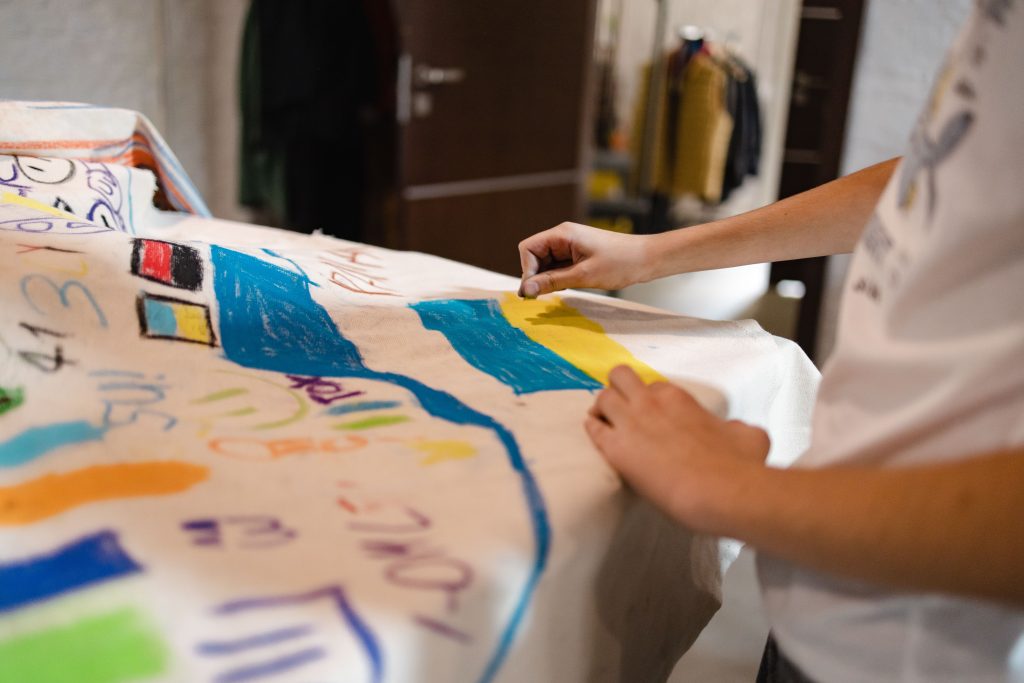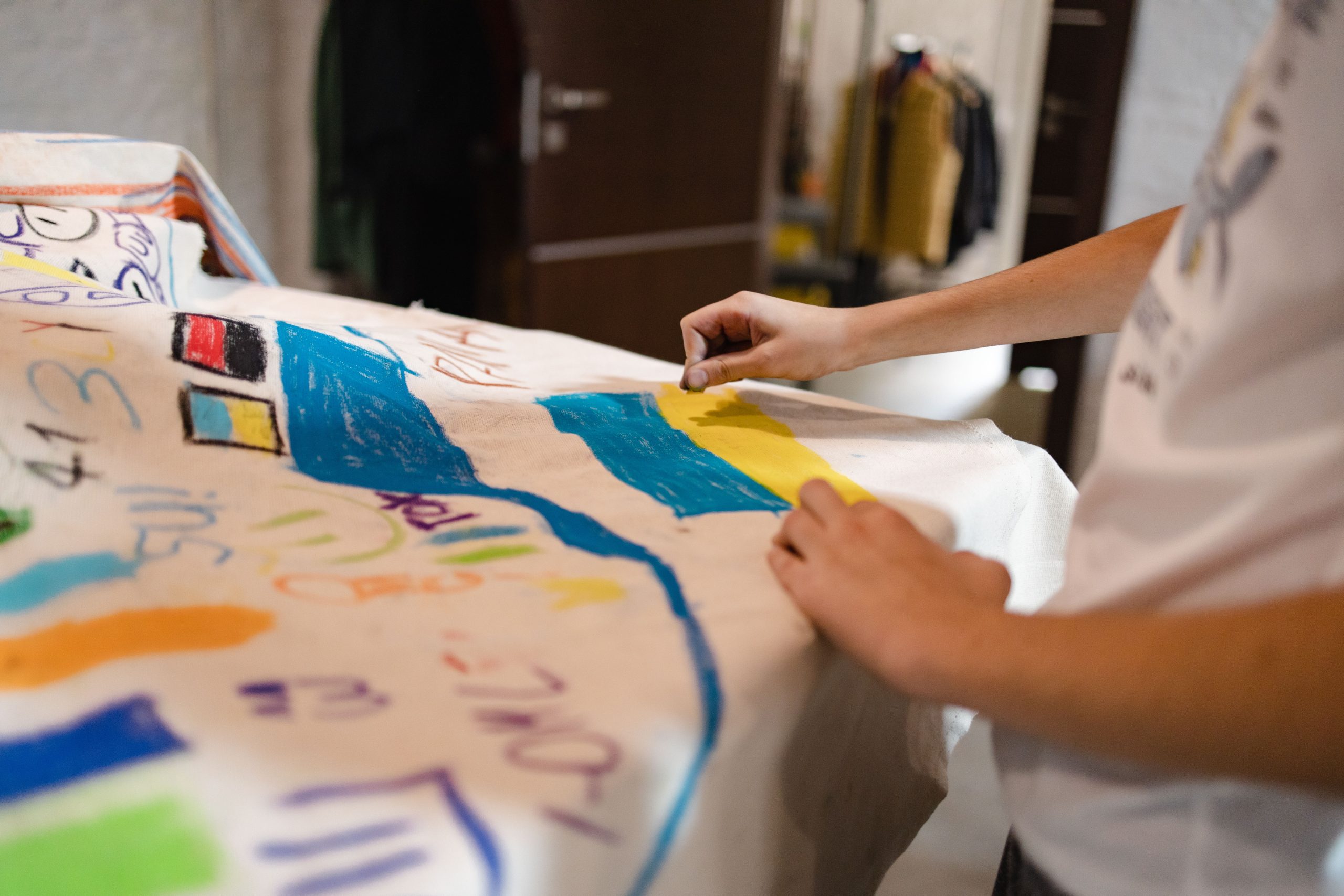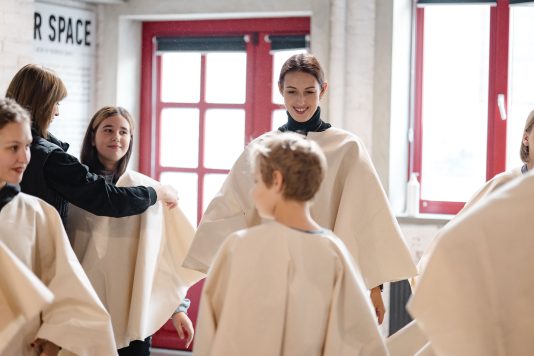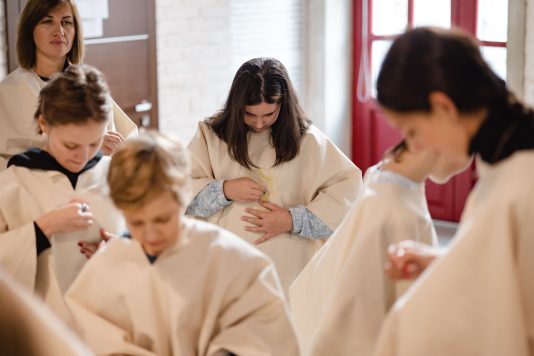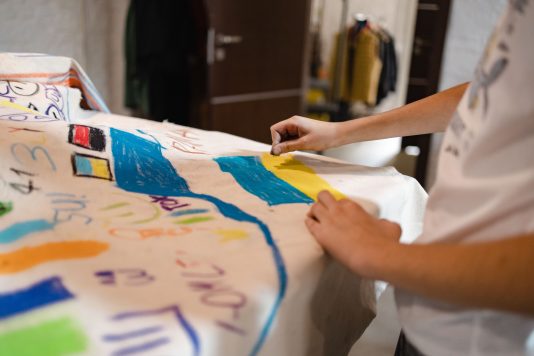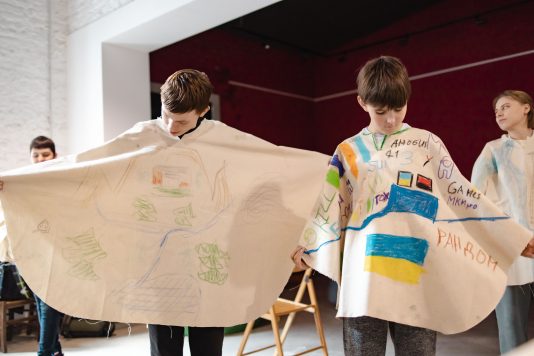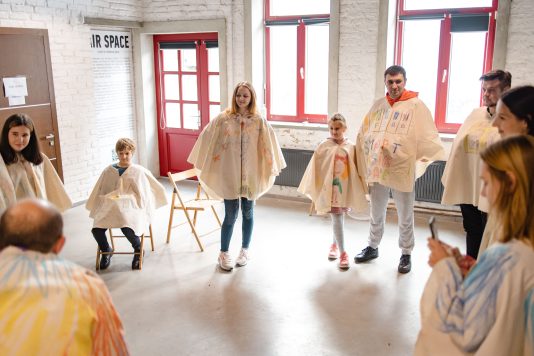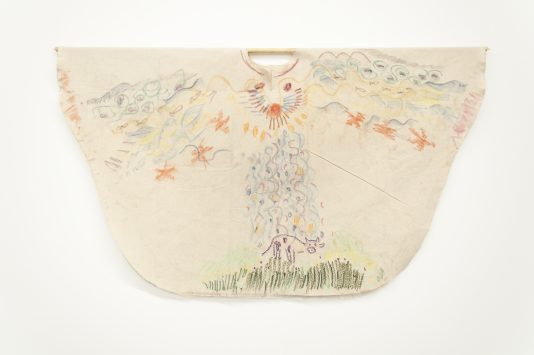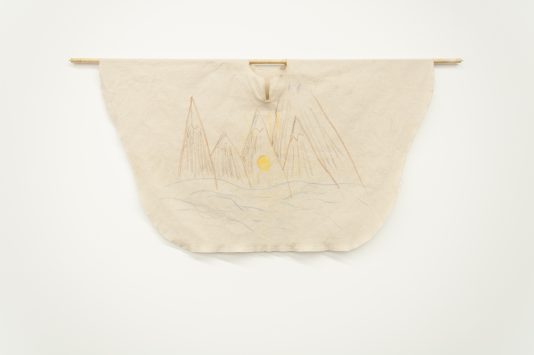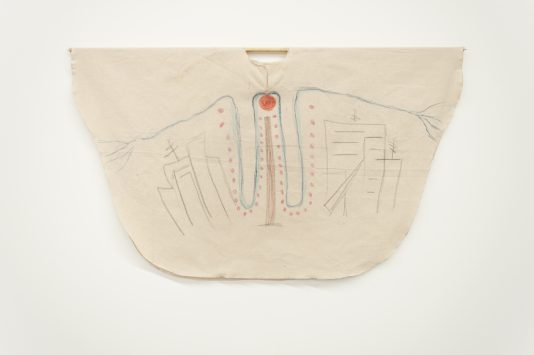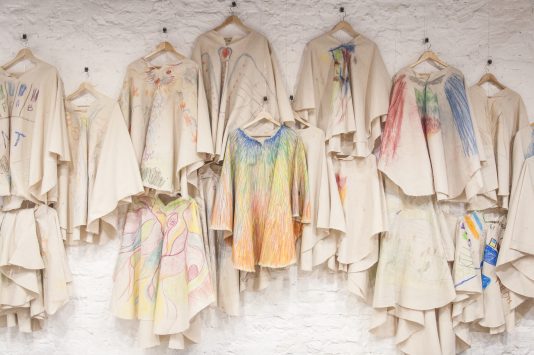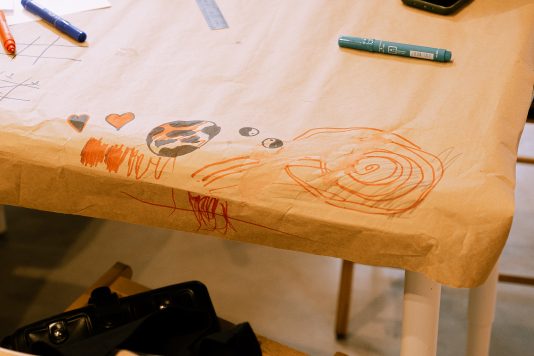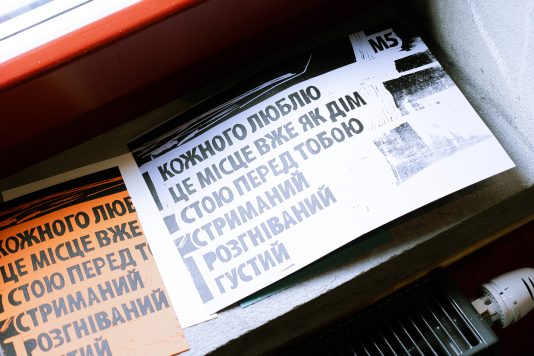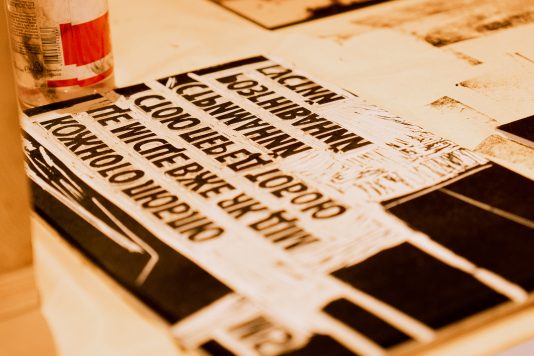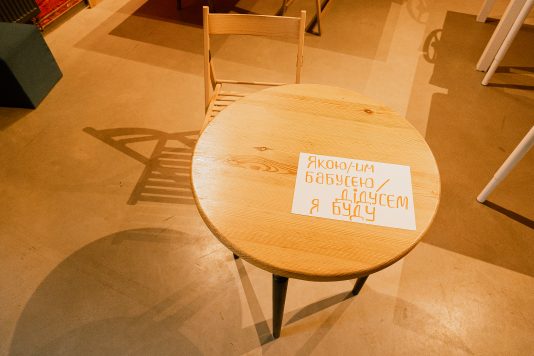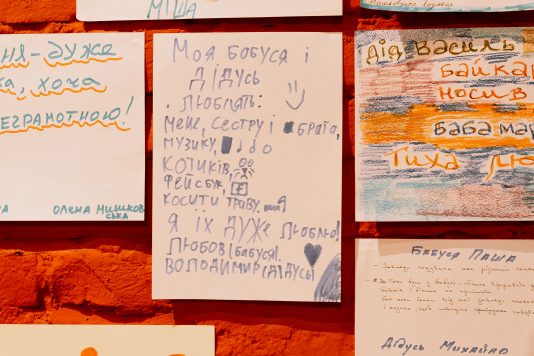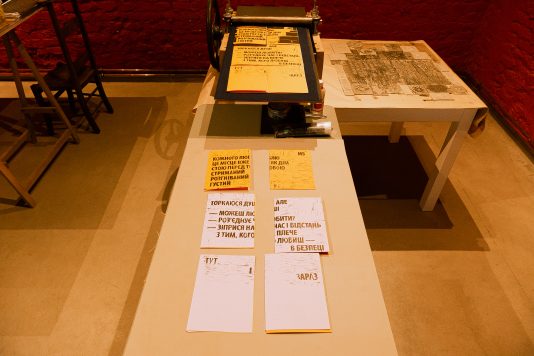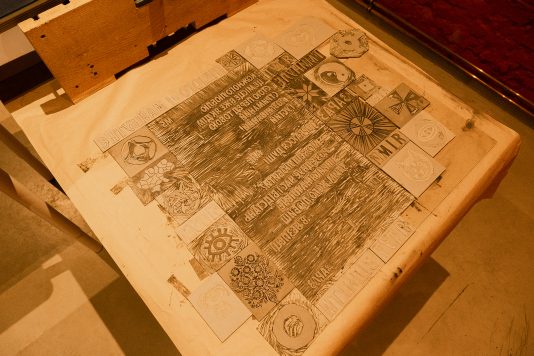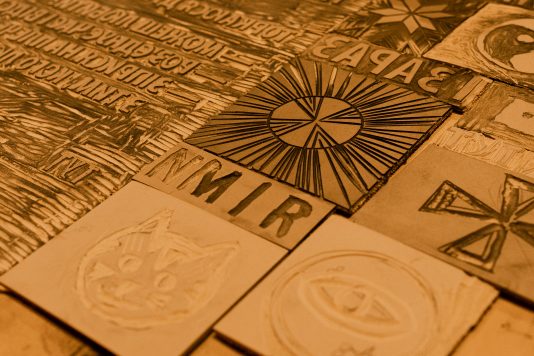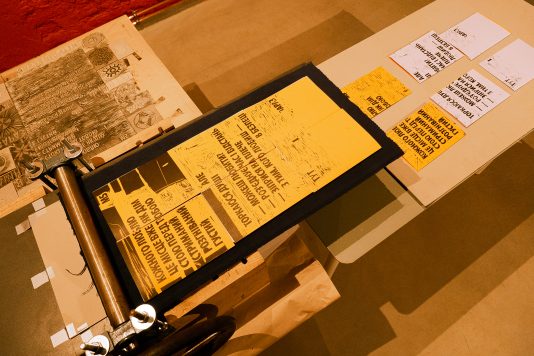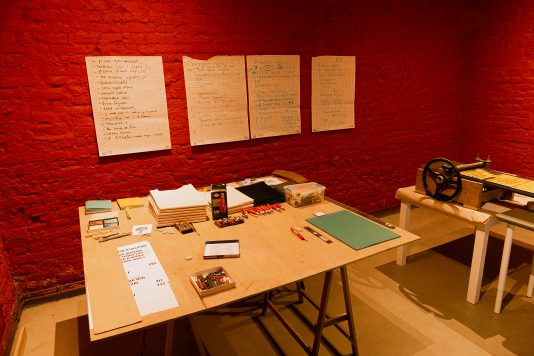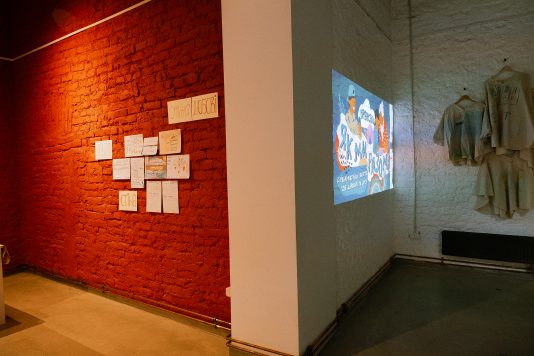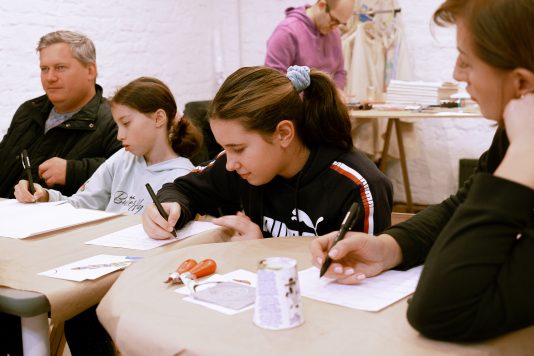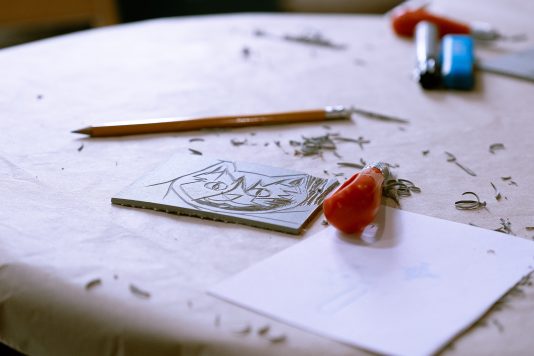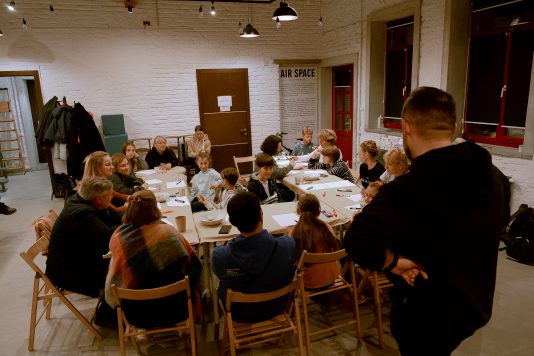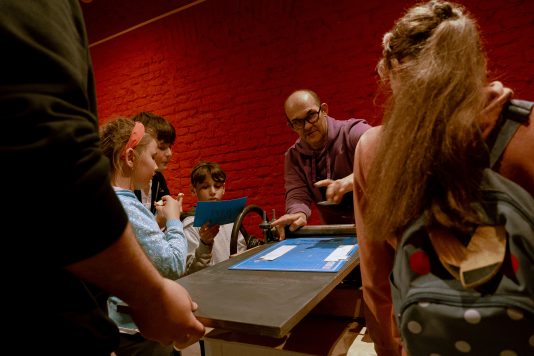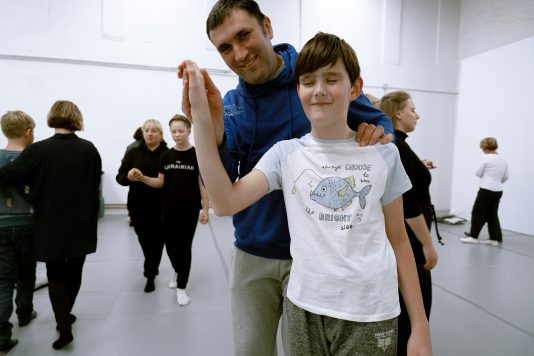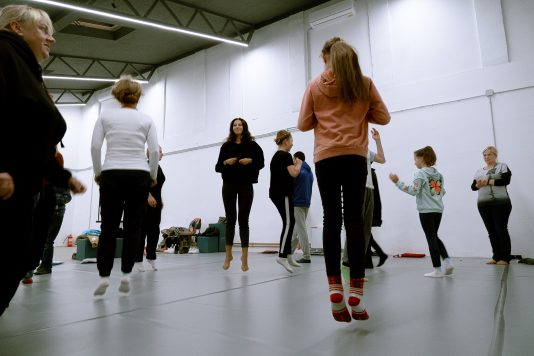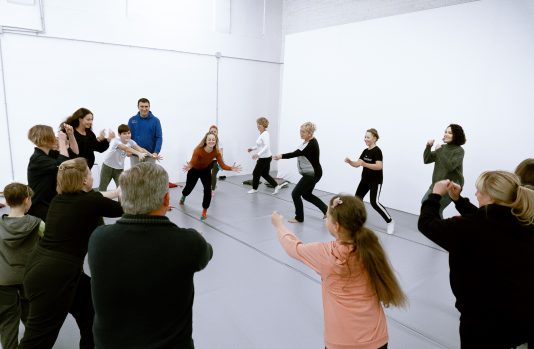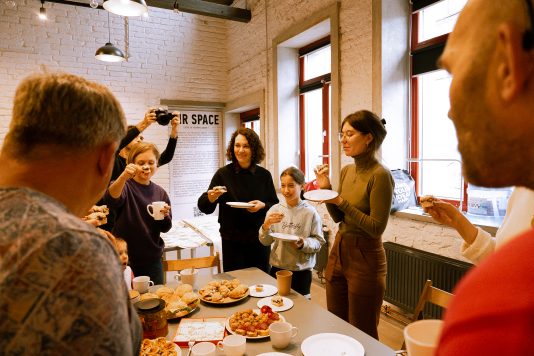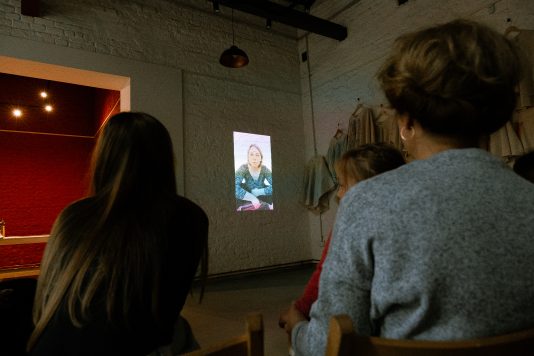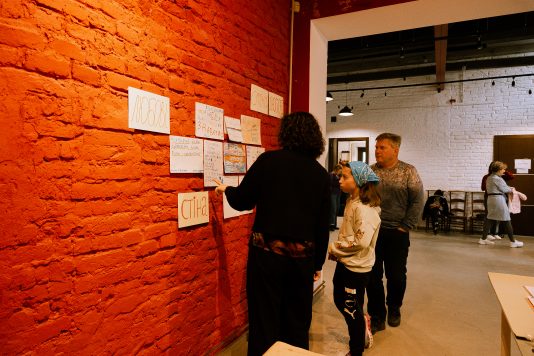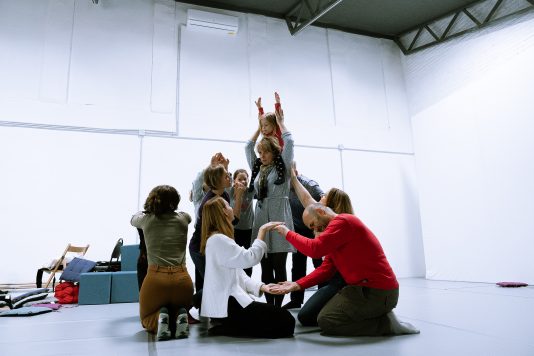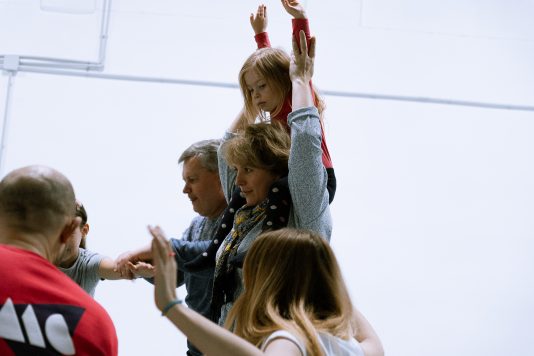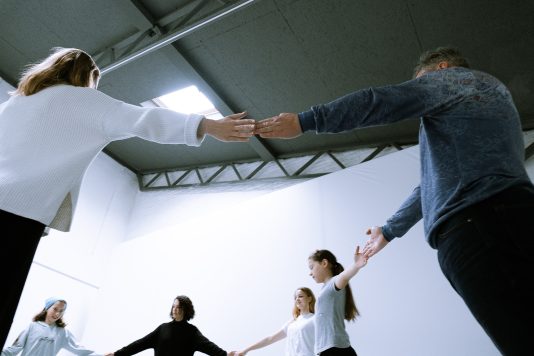Residency artists: Yuliia Kosterieva, Yurii Kruchak (“Open Place” Group), Nina Khyzhna, Iryna Harets (Ukraine)
Residency place: Jam Factory Art Center (Lviv, Ukraine)
Practice: multidisciplinary process (theatrical-performative, body-oriented practices, linocut, poetry, oral stories, video, drawing, etc.)
Collaborating artist: Rostyslav Kuzyk (Ukraine)
Curated by: Liuba Ilnytska, Anna Gaidai, Bozhena Pelenska.
Context
The war has ruined our usual way of life and ties, so, every day, we have to realize the new dimensions of (in)security and facing a different environment. A favorable environment prompts our bright sides and gives strength to move on. Even in the darkest times, we can create such environments in places we ended up forcedly – under the new conditions and in new places, among people and processes we don’t know. On top of that, we also need support and mutual understanding from our close people, especially relatives and even more so, when it is war time. The global velocity that was already extremely high has become frantic in recent months. The amount of essential-for-life work we do now is both inspiring and incredibly exhausting. Due to the constant fatigue, our communication with those we love, who also make efforts to resist the daily challenges, is reduced to formality with an increased feeling of distance. The crisis of communication is predictable to some extent, as war took away our spare time, filled up the space of thoughts and emotions. Many families, while struggling for life, volunteering, moving, searching for work and livelihood, encounter the lack of communication between parents/guardians and children. How We Are Together Project intended to improve the mutual contact for families experiencing communication crisis, as well as to expand the circle of support.
While applying the creative practices during this project, we have traced the best combining factors for (temporary) community and family members, effective collaborative processes and those requiring improvement. It was of importance for us to understand the potential results in the group. It may be considered a model for deploying similar environment in new venues, or in the circle of relatives and friends by project participants. If not, then, at least it can be seen as a personal experience and a collective memory of safe shared moments available that one can then rely upon.
In addition to joint research, each participant came through their own journey of better understanding themselves and mastering those practices they felt the most comfortable with.
Community
We all, the Ukrainians, undergo the common experience of war and feel distinctly that we are united now, as never before. We started perceiving ourselves as a community throughout the entire territory of Ukraine and even beyond. A community that resists the genocide and invasion. That is why our curatorial team did not mark the community of How We Are Together residence project based on a certain geographical criterion. This approach is not acceptable this year. We preferred working with people in Ukraine in general, in a broader sense, trying to realize the war that affected and caused harm to each person’s family. Stas Turina, the curator, artist and volunteer, hit the mark when he said grievously, “Ukraine with disabilities”, meaning that we all became people with disabilities in our country during this Russian war in Ukraine.
While reflecting on how the war has changed our families, our curatorial team was firstly paying attention to our own experiences, capabilities and needs of our families, as well as the Jam Factory Art Center’s team experience, as we could articulate it from the first-person perspective. Throughout these ten months of a full-scale war, we were the refugees with children abroad, and those who returned back to Ukraine, we had an experience of starting from scratch in a foreign country, we know how it feels to be away from home without knowing whether you will return, and if there is someplace to return to, how to live without electricity and heating during winter, how to cope with no communication with the family under occupation and how to have friends in the army… how, how, how… and how to support others, and yourself in coping with a terrifying new experience.
So, we focused on our inner support mechanism that allow us meeting the challenge of this war, and which we can build while in the creative process. Second, we set the project objective to resume ties and support within the family and build new ones with other families. We defined the project community as families with children who have lived in Lviv for a long time and children with parents/guardians from other regions who have been in the city since the beginning of the full-scale Russian invasion of Ukraine. It was important for us that Staying Together becomes an integration and acceptance space, as well as establishing face-to-face communication, spending time together consciously. Ultimately, this art project was meant to be an impetus for creating spaces of trust, safety and mutual support, where everyone feels free and comfortable expressing their thoughts, movements and emotions, where all participants can share and learn, as each of us represents different experiences and knowledge.
Residents
In our choice of artists, we considered their experience in art therapy classes, working with children/teenagers, as well as experience of community cooperation. We welcomed artists for collaboration from various regions of Ukraine: Nina Khyzhna and Iryna Harets, Yuliia Kosterieva and Yurii Kruchak.
Nina Khyzhna is a theater director, choreographer, and actress. She worked at the Kharkiv Independent Theater “Nafta” where she produced, among others, “Apollo” and “The Temple”, participated in the Polish-Ukrainian “Maps of Fear/Maps of Identity” performance project, directed “The Vicious” at the Varta Theater in Lviv. The physical theater is her special area of interest. She is experienced in physical therapy and working with children. Following the full-scale invasion, she held anti-stress trainings in Graz (Austria) for people who were forced to flee from Ukraine.
Iryna Harets is a playwright, writer, screenwriter, director, and psychologist. She manages the Theater of Modern Dialogue in Poltava, is a co-founder of the Theater of Playwrights in Kyiv. She is a finalist and prize winner of Ukrainian and international dramaturgical and literary competitions, coach on civic competence, creation of social theater platforms, informal education for children and adults and creative thinking. She is the author and curator of social projects. Harets is also the founder of UkrDramaHub – the All-Ukrainian Library of Modern Drama, founder of the “Lypnevyi Med” Drama Competition. Iryna has a vast experience in working with communities of different ages. She implemented projects in the eastern regions of Ukraine. Since 2014, when the Russian war against Ukraine broke out, she worked with internally displaced persons in the socio-theater documentary projects on various occasions. Iryna’s practice of working with communities includes stories, texts, personal statements of participants.
Yurii Kruchak and Yuliia Kosterieva are the “Open Place” public association founders. Their creative and curatorial work includes video art, monumental art, public art, multidisciplinary practices, with a focus on community collaboration and inclusion, research and settlement of conflicts in new groups. Their works in public space transform the audience into actors, creating a community consisting of artist and viewer, whose behavior and interaction serve to interpret and reveal social structures in the urban environment. Their creative practice addresses not only the relationship between art and real life, but always react to the relationship between the artist and the audience. Recent Open Place exhibitions and collaborative projects include: “Migration in Transition” Flux Factory, Long Island City, New York, USA 2018, “Gotong Royong. What we do together”, CCA U-jazdowski (Warsaw, Poland) 2017, “In-between the Revolution and War”, Skövde Art Museum (Sweden) 2016, “Local – New Global”, (Austria, Poland, Ukraine) 2009- 2014.
Research
How We Are Together art residency consisted of research and direct community-based activities. The research included Yurii Kruchak, Iryna Harets and Nina Khyzhna visit to Lviv, meetings and consultations with guest experts in the field of literature (Halyna Kruk), psychotherapy (Solomiia Bura), history and sociology (Iryna Sklokina, Natalia Otrishchenko, City History Center), interviewing and collecting oral stories (Andrii Usach, After Silence). During their week-long visit at the end of August, the artists and project team held live discussions, shared their approaches to work, and immersed themselves into the context of Lviv – a city that became a kind of hub for internally displaced persons from different parts of Ukraine during the full-scale war, which encountered a number of challenges related to the integration of new residents and ensuring the critical infrastructure capacities. In addition, this was a very important time to consolidate the idea of multidisciplinary residency, building up the subjects and structure of community-based practices, planned to be implemented in October, a month after the visit.
Residence methodology
How We Are Together project development started with outlining the important anchor questions that kept us moving in the planned direction during the further development of the art residency: Who is our community? What do we want to change/improve for the community? Why? How? After we captured the answers to these questions in the project concept, as well as identified the objectives, this document became our starting and reconciliation point, a very practical guideline we continuously referred to. We have checked ourselves at different project stages, namely, whether those subjects and practices of community-based interdisciplinary processes, the ideas of which are emerging, could bring about changes.
At the same time, every member of our working group realized how many factors affect the course of events during war, that everything changes quickly – people are moving, power and water supply stops, because of the missile strikes, everything stops during the air raid alerts and people stay in the shelters, etc., so, we kept flexible to the need for changes in the residence project.
In our opinion, the interdisciplinary process of artists and community co-creation should contribute to the achievement of the project goals. Therefore, we offered artists from various artistic areas to join the residency. Interdisciplinarity was to be implemented through alternating art practices (performance, theater, visual art, linocut, literature), body-oriented and art-therapeutic practices. Following several months of discussions between the artists and the Jam Factory Art Center’s team, as a project group, as well as live meetings in Lviv during a research visit, everyone involved got a real feeling of what a joint interdisciplinary process could be and how it should be built. This community-based collaboration process was then defined as a journey, an integral story that was supposed to start with self-perception, comprehension of own body and its boundaries, comprehension of own state, “I am here and now”, followed by setting up to the “Feel the other”, understanding of “How I perceive my parents. How my parents perceive me. How I perceive my child. How my child perceives me,” accepting of what has happened, “I am here and the past” and planning my own “I am here and the future.” Our shared journey was aimed at revealing the invisible tie between the “Past, Future, and Present” and coming to ourselves in the current state as part of shared process “I and We are here.”
“To the largest extent, the war is about losing control over own body, own life, over chronology – such a broken present, past and future” (Nataliia Otrishchenko, September 2022). Referring to Otrishchenko, Yurii Kruchak noted that the impact of state policies on its citizens is generally such that it separates us from our own body, especially when it comes to the self-dedication to the common service. Regaining control over own body means conscious effort and time dedicated specifically for this purpose time. Participants in the How We Are Together project had time and place, where the practice of regaining control over their own bodies occurred tactfully, in a game format. We aligned art-based and non-art-based practices, so that everyone involved could feel not only community and unity, but also show, which is critically important, the individuality, as well as finding something new in themselves and others, and accept the difference.
Location of the community meetings depended on bomb shelter availability, so we did not consider open public spaces. The open sky in Ukraine ceased to be safe. Therefore, all interaction occurred in two premises on the territory of the Jam Factory Art Center complex.
The structure of How We Are Together art residency was quite classic. However, it is worth of noting several important issues: we discussed and coordinated a lot within the working group at each of the project stages; we documented and archived methods and practices, recorded interviews; we collected all the materials to compile and publish “How We Are Together Methodology” brochure and generate institutional memory.
Practices and process
Our classes combined theatrical and art practices. We started each meeting with a check-in and collective active training by Nina Khyzhna to set up and launch teamwork, and feel the state of each of the participants. Then, trainings were flowing into theatrical exercises: creating individual, paired, group sketches, presenting one’s family story, turning everyday stories into theatrical flexible scenes. Participants worked here as a team, got to know each other and interacted through theatrical practices. Through family stories, people also talked about themselves, the region they came from, their own life, preferences, and experiences. Day-to-day activities were focused on everyone outlining their own state first, manifesting themselves, and then paying attention to the other, their inner world. The proposed exercises did not deal with war, but its shadow marked all areas of our lives; therefore, the context of war constantly appeared in the stories by adults and children.
Art classes took place mostly after theater classes and covered various techniques. During the first session, participants created a picture of a river or another body of water on a fabric poncho. With these pictures, children and adults reproduced their dear places and memories. Poncho coloring was an introductory practice for participants to get to know each other. The work was done individually here, but it revealed the inner world of each and every one before the group. Linocut was the main art practice the group devoted most of its time to. Such a class, which involved a focus on an individual work and gave satisfying tactile sensations, aptly complemented the moving and conversational theater classes and provided the participants with an opportunity to familiarize themselves with an artistic technique unusual for them. Throughout the project, the participants worked on a shared linocut where they visualized a collectively written poem. In order to support the group working over text, Yurii and Yuliia invited the poet Rostyslav Kuzyk as an expert, who held several workshops during which the group wrote a poem:
Кожного люблю
Це місце вже як дім
Стою перед тобою
Стриманий
Розгніваний
Густий
Але
Торкаюся душі
– Можеш любити?
– Роз’єднує час і відстань
– Зіприся на плече
З тим, кого любиш –
В безпеці
Тут
І
Зараз
[I love everyone
This place is like a home
I am here in front of you
Staying
Reserved
Enraged and
Dense
But
I touch the soul
- Can you love?
- Breaks apart time and distance
- Lean over shoulder
With the one you love-
Staying safe
Here
And
Now]
Participants went through many communication-focused activities during classes. Unexpected discoveries between children and parents became the most valuable moments. As one of the participants noted at the last class, “I discovered a lot of new things about my own son.” Situations were special indeed, since children talked about their parents, for example, filming their video portraits, and it was clear how attentive they are to the feelings of their relatives, how they note what is important and valuable for them, what traits of character and behavior they highlight.
The group created a number of linocuts during the project, a jointly written poem, artistically designed texts about their own family, a collection of colored ponchos, short videos, where parents and children present each other, self-made postcard books. We collected all the works created in an exhibition during the last days of classes.
Residents about their practices
Nina Khyzhna: “I integrate body-oriented practices into people and community business. These are techniques that allow establishing the contact with myself, my body, physicality, emotionality, with cognitive processes, and between these layers, what I am thinking about now, feeling and how it manifests in the body. How can we adjust one layer through the other, how can we establish these harmonious relationships within ourselves and with the outer world, with people and with space. For me, it is always important to first give people a sense of resilience, a sense that they can rely on themselves, that they are aware of themselves in the moment as much as possible, understand what is happening to them. To give techniques that help a person to cope with its own state, to meet its needs, to name them, name their emotions, and simply relieve tension, let out the stress, anxiety, and fear, let these manifesting feelings flow through the body. That is, to find an eco-friendly way to show one’s inner state and also share it with other people. Next, we are already on a way to contacting the other. We learn empathy, acceptance, how we can also understand another person’s body language, understand another person’s state. And here, such simple and understandable game techniques really come to help, allowing us to find these points of intersection. In particular, we know many of them from the theater, where, regardless of age, we can also give space to our inner child. And, in fact, to realize that we are all complex, but at the same time simple, made up of cells and experience to a greater or lesser extent the same basic needs. Safety needs, the need for acceptance, to be heard, to be seen, to feel, to have a sense of affiliation. So, when we realize that we feel similar things to a greater or lesser extent, it becomes not so scary. Then there is more space to show yourself, show one’s own authenticity, and just actually be yourself.
For me, this was a very valuable case of cooperation with you [Open Place]. Interdisciplinarity that occurred here, these tools really fit together very well. The body, the creation of something, multi-faceted approach, in more intellectual terms, more sensual terms, in terms of doing something with one’s own hands, how we can deal with the same problem in various ways.”
Open Place (Yurii Kruchak and Yuliia Kosterieva): “Our program is based on the work with text, images, understanding of processes that take place inside a person, inside the society. This is exactly what we focused our work on. One of the tasks was to rethink the processes that take place in the human mind to the processes that occur within society.
Our journey was divided into segments, stages. The first one was to describe oneself [using poncho], where people were asked to understand themselves in the world they are now, that is, they feel they live in. This was the first such station on this pathway. Then we had a stage when we translated our feelings into short messages, and these were separate phrases. At this stage, we invited Rostyslav Kuzyk, who is engaged in poetic texts.
It is important for us to preserve this uniqueness of a human, which is based on a certain experience, on a certain culture, on a certain understanding. And the exercise to describe oneself gives a person the opportunity to combine, to a larger extent, a certain form, how it perceives itself, and certain content. This is quite a vivid example of how a person should not be afraid of making mistakes and just be its true self. This is very important – to preserve the uniqueness of a human. Here is already the second stage, when we started working together. Here it is important to find a scheme of communication between different experiences, between different people, between different age groups, a certain structure of relationships and understanding. When a person perceives the experience of somebody else as its own and trusts a certain space for action. And vice versa: another person, understanding the experience of a colleague or a friend, can sometimes make a decision that was difficult to imagine before. It was the building of exactly these ties and trust that was important in our work. At least building a practice that would give experience of how it could happen.
The uniqueness lies in the fact that in Lviv we worked with both teenagers and adults. This is quite difficult, as there is a certain age difference. Children are more active, less engaged, less reserved and there is a certain difference in dynamics. It was quite difficult, but it turned out to be possible. Here we also need to thank Iryna and Nina, who worked on theatrical and performance practices that were of a great help too.”
Iryna Harets: “My responsibility in this project is the theatrical part. My work is mostly focused on texts, understanding oneself in this point of time, space, and history. Mostly, we work precisely on accurate phrases that would describe our state closer to reality. We worked on the love story, because when I offered to talk about grandmother or grandfather, we referred not only to the family history, the history of places they used to live in general, but also such an unconditional love. In most cases, I heard that sometimes grandparents give something that no one else can give a person throughout their entire life. They give that love for which they want nothing in return.
I see how both adults and children really want to share what is happening to them. And this is very true and important, because if one doesn’t speak through, I don’t want to call it a trauma, although it is a trauma, this is a war, then one won’t be able to cope with it in the future. In addition, there was such a moment of rethinking that the story is different. And it is different in different regions of Ukraine.
Do you know how to measure the effect? Well, when we came today, children and adults hugged us. This means that we have probably done something right, if people want to hug you – it stands high. And I appreciate that.”
Afterword
News about How We Are Together art project in Lviv appeared on TV show called “Rocket attack, lying in repose with Heroes and heating stations | 31.10.2022”, reflecting to the fullest extent the state of affairs and the context the Ukrainian residents are staying in. Therefore, it is currently difficult to imagine the creation of safe spaces; however, we created common safe moments during the meetings of How We Are Together program, thereby building points of support for ourselves and our loved ones.
Since the beginning of the full-scale invasion of Russia into Ukraine, some of our colleagues are constantly staying abroad, so not all of them managed to come to Lviv during residency. In particular, the artist Yuliia Kosterieva and curator Anna Gaidai’s insight into community cooperation process during classes in the premises of the Jam Factory Art Center evolved due to the reflections of colleagues and other residents, as well as the community feedback. At the same time, the previous experience of community-focused art projects helped to a greater extent with perceiving the context and insights. “Mom, help me with a drawing of the Crimean mountains,” – asks one of the participants. This is an appeal to the memory and experience of another person, a request for knowledge about what was not seen. On the one hand, we need to learn about things that resonate with us from those who know and have seen them, and on the other hand, those who know and have seen things need to tell and share it in order to live in full and move on. Psychologist Svitlana Roiz shares her observations on the state of the Ukrainian society through her own experience. One of her observations is that we all need witnesses to the reality of our lives, and we can open these witnesses to those “ours” with whom we have a “shared reality”. That is, in order to become “ours”, we create a “shared reality”, in particular in the How We Are Together project, in various forms – live, online, in a group, or face-to-face, with parents and children, with families, with a team and artists.
Critical experiences have a strong impact on human formation; they change adults and transform the reality that is normal for children. Since the beginning of the full-scale war, we feel more than ever how important it is to share such an experience with those we love, go through it together, be able to express our emotions before others, knowing that these will be accepted. The How We Are Together project created a space for communication and, at the same time, a place where one can take mind off their troubles, spend quality time with the beloved ones, and meet new people. Adults came to this project for the sake of their children, but in the process, we saw how they themselves enthusiastically participated in a theatrical game or cut a linocut with pleasure, how they found interlocutors. In a certain way, the children legitimized the art-based activities of adults, which they would not have organized for themselves personally. On the other hand, teenagers are keener to collective activities with their peers, but rarely interact with their parents in the space of games and art-based activities. It was a joy to watch those discovering new facts about family members and getting to know their parents through shared play. An important aspect was the involvement in the project of families who had to flee to Lviv from the eastern and southern regions due to warfare. We noticed that these families almost never missed classes, traveled to the art center even from remote areas and were more motivated than Lviv residents who have lived in Lviv for a long time or all their lives. This indicates the importance of measures that promote the integration of displaced persons in the new city. Among our participants there were a mother and a daughter, who learned about the project from a poster, placed on our art center building, and started attending classes because the area lacks places, where residents can spend their spare time creatively. This case highlights a demand for shared leisure spaces in our area, and a lack of such places and activities as well.
The process of community-based cooperation through How We Are Together art practices allowed participants to understand that in order to express their inner state and show emotions, they can turn to what is available at the moment. This can be, for example, tools for creativity, or one’s own body and voice, it can be a game, poetry or drawing over one’s own body and clothes. Thus, art practices with community members become practices of direct action as they result in true, conscious responses and emotions and lean on one’s own experience. In the same way, the art practices become inclusive.
Curatorial text by Anna Gaidai, Liuba Ilnytska
